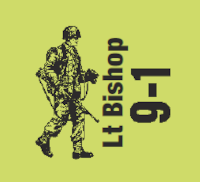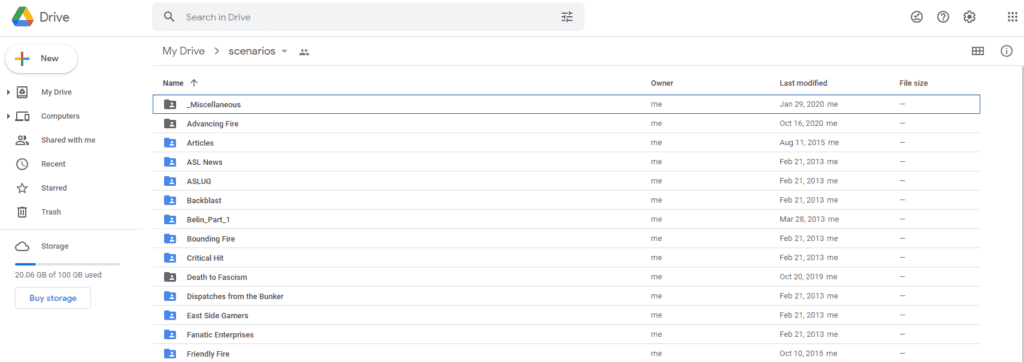
There has been some recent discussion regarding production of scenario packs. This led to discussions on selling packs in PDF format. From there discussion flowed into scanning existing scenarios.
As part of this discussion, people have asked how do you scan existing scenarios? How do you organize them? Where do you store them? How do I back them up? Can I access them away from home?
I began scanning my ASL scenarios more than a decade ago. I have scanned all of my scenarios. This includes scanning and storing ASL magazines and rules from third party producers. What follows is my experiences, how I go about it, and answers to the questions above. Let’s get stuck in.
First, A Legal Talk

I am not a lawyer. The laws in my country change daily on what is and is not allowed. There is zero chance I have an idea what the laws might be in your country. Do your own research to see what you can legally do. It may help to look into so-called “format shifting”, e.g. converting from a physical, paper-based medium to a digital one.
That’s a lot of words to say you do this at your own risk.
Second, A Moral Talk

If you copy the scenarios, don’t resell the originals. Doing so cuts into the sales of the producer. Based on the time and effort going into producing quality ASL products, they are very undervalued as it is. Producers are often working for cents per hour. Don’t take this away from them too. This also includes buying one pack and sharing it among many people. Please, be honest with your purchases. Personally. I shred my hard copies once I know the scans are usable and stored.
Enough proselytizing from the moral high ground from me.
Scanning

When I first started, I used a 3-in-1 combo printer/scanner/fax machine to scan my scenarios. It was very painful having to scan one side. Flip the scenario. Scan the other side. Remove the scenario. Put in the next. Ad nauseum. Then I bought my daughter a car.
In the US, at the end of the process, they give you a copy of all the documents with your purchase. You can ask for hard copy or soft copy. I asked for a soft copy. They brought a small scanner and scanned all the documents in seconds, into a single file. I was immediately hooked. The dealer was using a Brother ADS-1700 scanner. I immediately went to Amazon and bought one. I have been using the one beside my desk for over eight years. With it, I can scan a typical scenario pack in about 30 seconds, all into a single file. It quickly scans third party rules, charts, and other paper products in seconds.
Storing

I store all of my scans in the cloud. I use Google Cloud storage, with their Google Drive application. If you have a Gmail account, you have some storage included, 15 GB the last time I checked. If you need more than that, it is not prohibitively expensive to purchase storage above the free tier.
With Google Drive, you install a small application on your PC. On a Windows PC, this will create a new “G:” drive which works just like any other drive on your PC. You can drag and drop files on your PC onto that drive and they will be synced with your cloud storage.
Cloud storage puts the onus on Google to create your backups. This is what they do and precisely what cloud storage is built for. This coupled with the copy on your “main PC” should give you peace of mind against losing all the work you’ve done scanning all of your ASL products.
For remote access, Google Drive covers you there too. There is a browser-based access available a https://drive.google.com/. Browse to that address. Log into your Google account and all your files will be there. I have remote access on my phone, tablet, and Microsoft Surface Go. If I have my phone, I have access to my electronic rule book, third party rules, and scenarios where ever I am (with at least one bar that is 😀 ).
Personally, I scan at 300DPI and into PDF documents. Others scan at much higher resolution and into images. Images compress better and if disc size is important to you, an image scan might be better. In the end, this all comes down to choice so experiment to see what works best for you.
Printing
I don’t print anymore when I travel to tournaments. I find I can play off a tablet/Surface Go pretty easily. But when I did print them out, I used a small travel printer to print on demand. My opponent and I would use my tablet to consider scenarios and when we settled on one, I would print it out for play. I stopped this because of all the requests to print for others. It interrupted my games and buying ink to support other people got expensive.
Organizing

I have a top-level folder called “scenarios” It stores all of my scenarios. Inside this folder, I have another folder called “articles”. I store articles from other authors which I find foundational in there, as well as all of my original works. There is another another called “Miscellaneous”. I store some original counters I used for Special Ammo depletion (Thanks JR!), my Raaco storage labels, some .stl files I use for printing Raaco inserts, and some ideas I have for scenario designs I have.
After that, I have a folder for every ASL producer. I place scans into these folders. Inside these folders, I have sub-folders that work for me. For instance, in my “Bounding Fire” folder I have sub-folders called “Beyond the Beachhead”, “Blood & Jungle”, etc. Inside of those I have scans.
Originally, I scanned every scenario into its own file. The file would be called “<scenario number> <scenario name>.pdf. For instance, “BFP 014 Opening Phase.pdf” is an example of one file from BFP’s Operation Cobra. Also notice the “014”. This is because the system sorts scenarios alphabetically. “BFP 11” will appear BEFORE “BFP 2”. Turning everything into a three-digit number solves this.

These days, I scan the whole pack into a single file. I name these files after the product and include the first scenario and last scenario number in the filename. This way I can locate the specific scenarios by producer, product, or scenario number. In the odd case where I am not sure where it came from, I can visit ROAR or the ASL Scenario Archive to identify the product.
When I want to play a scenario, I can print the specific page or pages I need. This works particularly well if playing face-to-face. When playing online, I used a “PDF Printer” to “print” the specific scenario into a PDF file of just that single scenario. I can then share that specific file with my opponent just as if I were at the table.
Conclusion

One added benefit I haven’t covered is I no longer need to carry 40 – 50 pounds (18 – 22 Kg) of binders to tournaments any more. All I need is my tablet. When I was printing, my printer weighed in at under 2 pounds (1 Kg). I added a ream of paper for another 2 pounds and I was still way ahead on weight.
For those considering the transition to digital storage, I hope this helps you understand some considerations you must weigh when doing this. This has worked wonderfully for me and I don’t regret my transformation one bit. The difference in tournament travel alone has been liberating for me. Knowing I have access to everything I own with the click of a few buttons has significantly lightened my travel load. I wouldn’t have it any other way.
Until next time. – jim


Both you and I are doing pretty much the same thing — scanning, filing, etc. I am scanning at 600×600 dpi, but using a compact pdf format, which results in a single page scenario file of about 300 KB, rather than about 1.5 MB without that compact format.
One thing I also do with articles is to “split out” an article from Journal or Annual and store it under its own title in a topic file (Armor, Airborne, etc)
I didn’t consider that when I started. I have come close a couple of times to purchasing Adobe Acrobat to allow me to edit my PDFs. I would do it today except they moved to a subscription model and I have no desire to pay for a whole year up front. Especially given this is the price the software used to be. Perhaps the time has come to see if there is a reasonable open source alternative to acrobat.
I’ve started scanning recently. I still use a single file per scenario, and that works for me although your way is much faster.
A question, what do you do with the paper copies? I’ve been filing them, but that seems a waste of time and space since I’ve got everything scanned.
I shred them and turn them into the recycling center. IMO, storing them is a waste of time and space. – jim
I’ve been scanning for at least a dozen years so that I’d have a backup of the original. Then when I moved cities, I thought: “why move a couple dozen binders of paper when I have everything on my Mac and iCloud?” It was a great decision. I recycle the originals after scanning. Saves a lot of time when prepping for a tournament, too, because I no longer need to go search and pull individual scenario cards from any number of binders…and put them all back when I’m done.
I have been toying with the idea of storing the digital scenarios by categories such as beach landings, air landings, cavalry, etc ? Any thoughts?
If it works for you, then it should be good. Sitting and thinking about it for just a moment though brings to mind some issues. What happens if a scenario fits two categories? Do you store two copies? Do you create a link in one of the categories to the scenario in the other? It becomes a little crazy to think about.
If you are going to go this route, then I think you should just go all in. Rather than store them in categories, create a meta data arrangement around the content of scenarios and catalog each one accordingly. Then you could do things like record sides, record OB (for one or both), record air support, record number and types of AFV, etc. Of course, one of the things you would record is the file name and possibly a URI to the file so you could pull it up. In this way, if you wanted to find all night, beach assault, scenarios featuring OBA, Tiger I AFV, against Belgian Cavalry, you could find it.
One decent approach is on the Scenario Archive. Clearly, this is a LOT of work.
My 2 cents:
I developed a Excel spreadsheet for all of my scanned scenarios. It includes title, date, theater, & attacker/defender nationality. To your question above I also include a few classifications as far as night, air support, amphibious, air landing, etc.
I don’t overdo it though. It is easy to go overboard. For example I don’t have a classification for OBA or armor. That’s getting too far into the weeds for me.
I also hyperlink the title to where I store it so all I have to do is click on it and brings up the pdf.
The nice thing about excel is you can filter things. So if I want a air landing scenario, I can filter those out and take a look at just those.
It is a ton of work initially but I find now as I add scenarios over time, it does not add a ton of time.
Thanks for the feedback